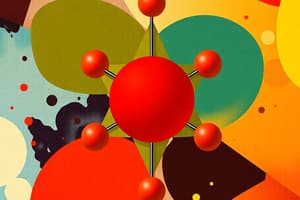Podcast
Questions and Answers
What are the three main factors of the repulsion theory?
What are the three main factors of the repulsion theory?
- The electron pairs around the central molecule determine its shape
- The electron pairs around a central nucleus are trying to repel each other as much as possible
- Different numbers of electrons result in different shapes
- All of the above (correct)
What shape does 2 electron (bonding) pairs result in?
What shape does 2 electron (bonding) pairs result in?
Linear / planar
What shape does 3 electron (bonding) pairs result in?
What shape does 3 electron (bonding) pairs result in?
Trigonal planar
What shape does 4 electron (bonding) pairs result in?
What shape does 4 electron (bonding) pairs result in?
What shape does 5 electron (bonding) pairs result in?
What shape does 5 electron (bonding) pairs result in?
What shape does 6 electron (bonding pairs) result in?
What shape does 6 electron (bonding pairs) result in?
What shape does two bonding pairs and two lone pairs result in?
What shape does two bonding pairs and two lone pairs result in?
What shape does 3 bonding pairs and one lone pair result in?
What shape does 3 bonding pairs and one lone pair result in?
Why do lone pairs of electrons repel more than bonding pairs?
Why do lone pairs of electrons repel more than bonding pairs?
What is the shape of an ammonium ion?
What is the shape of an ammonium ion?
What is the shape of carbonate ions?
What is the shape of carbonate ions?
What is the shape of sulfate ions (SO4 2-)?
What is the shape of sulfate ions (SO4 2-)?
What is the shape of a nitrate ion?
What is the shape of a nitrate ion?
Why might a covalent bond experience a stronger attraction from one of the bonded atoms than another?
Why might a covalent bond experience a stronger attraction from one of the bonded atoms than another?
What is electronegativity?
What is electronegativity?
How is electronegativity measured?
How is electronegativity measured?
Explain how hydrogen fluoride is electronegative.
Explain how hydrogen fluoride is electronegative.
What are the most electronegative atoms?
What are the most electronegative atoms?
How can we explain the difference between different bonds?
How can we explain the difference between different bonds?
What forms a pure covalent bond?
What forms a pure covalent bond?
What forms a polar covalent bond?
What forms a polar covalent bond?
Flashcards are hidden until you start studying
Study Notes
Repulsion Theory
- Electron pairs around a central atom dictate molecular shape.
- Electron pairs repel each other to maximize distance.
- The number of electron pairs influences the resulting shape.
Molecular Shapes Based on Electron Pairs
- 2 Bonding Pairs:
- Shape: Linear/Planar
- Bond Angle: 180°
- 3 Bonding Pairs:
- Shape: Trigonal Planar
- Bond Angle: 120°
- 4 Bonding Pairs:
- Shape: Tetrahedral
- Bond Angle: 109.5°
- 5 Bonding Pairs:
- Shape: Triangular Bipyramidal
- Bond Angles: 90° and 120°
- 6 Bonding Pairs:
- Shape: Octahedral
- Bond Angle: 90°
Lone Pairs Effect on Molecular Shape
- 2 Bonding Pairs & 2 Lone Pairs:
- Shape: V-shaped/Non-linear/Bent
- Bond Angle: 104.5° (due to lone pair repulsion)
- 3 Bonding Pairs & 1 Lone Pair:
- Shape: Tetrahedral
- Bond Angle: 107°
Lone Pairs and Repulsion
- Lone pairs repel more than bonding pairs due to closer proximity to the nucleus and greater spatial occupation.
Shapes of Ions
- Ammonium Ion:
- Shape: Tetrahedral
- Bond Angle: 109.5°
- Carbonate Ion:
- Shape: Trigonal Planar
- Bond Angle: 120°
- Features: One double-bonded oxygen to carbon.
- Sulfate Ion (SO4 2-):
- Shape: Tetrahedral
- Bond Angle: 109.5°
- Structure: 2 double-bonded and 2 single-bonded oxygens.
- Nitrate Ion:
- Shape: Trigonal Planar
- Involves a dative covalent bond with one oxygen (-2 charge), a single covalent bond (-1 charge), and a double covalent bond (no charge).
Electronegativity
- Defined as the ability of an atom to attract electrons in a covalent bond.
- Measured on the Pauling scale, which ranges from 0.4 to 4.0.
- Most Electronegative Elements:
- Fluorine (4.0), followed by chlorine, oxygen, and sulfur.
Bonding Differences
- Bonds vary in types based on electronegativity differences:
- Pure Covalent: Electronegativity difference = 0
- Polar Covalent: Difference between 0 and 1.8
- Pure Ionic: Difference greater than 1.8
- Pure Covalent Bond: Formed between identical or similar electronegativities, resulting in non-polar bonds.
- Polar Covalent Bond: Formed when there is a significant electronegativity difference, causing unequal electron sharing.
Example of Electronegativity in Molecules
- In hydrogen fluoride, fluorine attracts electrons more strongly than hydrogen, resulting in a partial negative charge on fluorine and a partial positive charge on hydrogen.
Studying That Suits You
Use AI to generate personalized quizzes and flashcards to suit your learning preferences.




